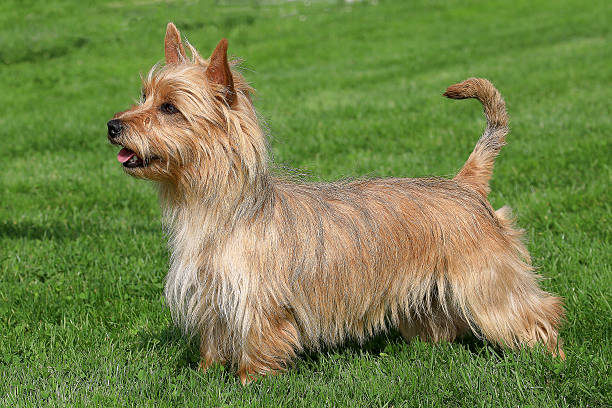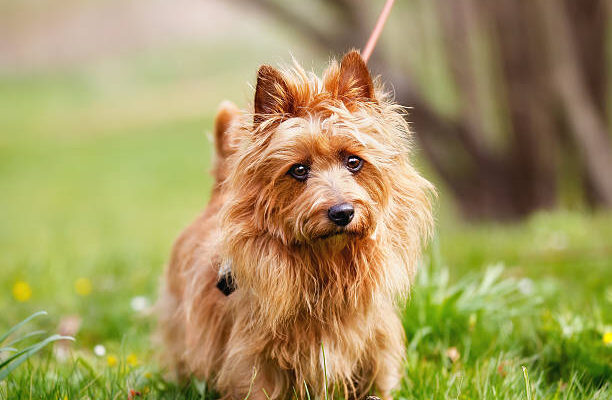This scruffy little Australian Terrier demonstrates high energy together with bravery and deep affection towards family while showing boldness in all situations. This complete reference book covers all Australian Terrier lifestyle features while describing its creation background alongside teaching approaches together with grooming requirements along with nutritional plans and daily maintenance expectations. The information you need about Australian Terriers exists in this guide both when you decide to adopt one or want to discover more about their characteristic traits.
Table of Contents
- Introduction to Australian Terriers
- History and Origin
- Physical Characteristics
- Personality and Temperament
- Training an Australian Terrier
- Exercise and Activity Needs
- Nutritional Requirements and Diet
- Grooming and Hygiene
- Common Health Issues and Preventive Care
- Socialization and Behavior
- Living Conditions and Adaptability
- Fun Activities and Games
- Conclusion
Introduction to Australian Terriers
Even though they stand no taller than a medium-sized dog the Australian Terrier displays incredible personality traits through their dense body structure. Originally born for Australian territory work the Australian Terrier maintains its spirited nature coupled with its rugged hardness and strong devotion to people who it loves. This breed prospers best when family members stay active and develops close emotional connections with family members. The lovable nature of this breed includes playing activities as well as exploration and protection which makes it a family-friendly companion.
History and Origin

Bred for the Outback
The development of the Australian Terrier dates back to 19th-century Australia including Tasmania when settlers required little but enduring dogs for rodent and snake management roles. A combination of Cairn Terrier, Yorkshire Terrier, Skye Terrier, and Dandie Dinmont Terrier served as source breeds to create the Australian Terrier while working as protection and rodent control dogs in Australia until the breed later became trusted as a dependable and capable working canine type.
Recognition and Popularity
The American Kennel Club recognized the Australian Terrier in 1960 which made it rapidly popular outside Australia. People today recognize the Australian Terrier for being an alert breed with a delightful temperament that stays loyal to its owners.
Fun Fact:
Historical records show that the Australian Terrier became the first Australian breed which achieved official recognition through dog shows.
Physical Characteristics
Size and Build
- Height: 10–11 inches at the shoulder
- Weight: 14–16 pounds
- Build: Compact, sturdy, and slightly longer than tall
Coat and Colors
The Australian Terrier displays a protective outer layer and tender inner fur consisting of two types of coat textures. Its rough hair texture teamed with a long “ruff” region around the neckline creates an enduring adventurous appearance.
Recognized Colors:
- Blue and tan
- Sandy
- Red
Despite its coarse coat, grooming is relatively easy and infrequent trimming is required.
Personality and Temperament
What Are Australian Terriers Like?
These terriers display fearlessness together with alertness as well as independence which are typical character traits of the terrier breed. As a breed trait you will find the Australian Terrier to be both snuggly and affectionate after its energetic play time ends. The Australian Terrier remains devoted past all reasonable limits while selecting one special connection with a specific human being.
Are Australian Terriers Good Family Dogs?
Absolutely. Australian Terriers display loyalty and affection in addition to their kindness towards children especially when the breed receives proper early socialization experiences. The playful disposition of Australian Terriers makes them ideal family dogs but families should supervise children due to their energetic nature.
Are Australian Terriers Good Guard Dogs?
The dogs do not have an intimidating stature but their keen senses combined with their strong poker-like barking skills make them effective watchdogs. These dogs will loudly announce suspicious sounds together with the appearance of foreign faces or unknown people.
Training an Australian Terrier
Intelligence and Trainability
The intelligence level in Australian Terriers comes with a touch of stubbornness in their personality. The dog quickly grasps information during time spent with enjoyable and rewarding sessions. Every training session with Australian Terriers should rely on positive reinforcement strategies.
Training Tips:
Keep training sessions direct yet appealing to sustain Australian Terrier focus.
Treating desirable behaviors and praising actions or offering toys as rewards.
Harsh disciplinary methods should be avoided since they might lead to resistance issues.
Train with kindness while also maintaining firmness along with consistency.
Socialization
When an Australian Terrier grows up without proper socialization it becomes argued to develop protective tendencies or excessive wariness of new individuals. Young Australian Terriers develop stronger confidence levels and refuse bad habits when they engage with different human beings along with domestic animals and multiple settings.
Exercise and Activity Needs
Daily Physical Exercise
The Australian Terrier requires physical activity throughout the day which should last between 45 to 60 minutes. Active terriers achieve their maximum contentment when their strength is drained through physical activities.
Best Exercise Options:
- Brisk daily walks
- Off-leash play in secure areas
- Fetch and tug-of-war sessions
- Trail hikes or park outings
Mental Stimulation
The need for mental stimulation in Australian Terriers equals their necessity for physical exercise because of their intelligent nature. An unstimulated Australian Terrier tends to engage in either digging habits or excessive barking and chewing behaviors.
Brain Boosting Activities:
- Interactive food puzzles
- Scent games and tracking
- Trick training
- Agility and obedience courses
Nutritional Requirements and Diet
Recommended Diet
For Australian Terriers the best nutrition comes from a specific small-breed diet which contains proper protein levels and balanced nutrients. The food selection must support joint wellness as well as immune response strength and coat vitality.
Ideal Foods:
- Lean meats like chicken, turkey, or lamb
- Omega-rich fish (like salmon or sardines)
- Whole grains (brown rice, oats)
- Vegetables like carrots, green beans, and peas
- Fruits like blueberries and apples (in moderation)
Feeding Schedule
- Puppies: 3 meals daily
- Adults: 2 meals per day
Excessive feeding of food should be avoided while high-fat treats need to be monitored due to increased joint stress from weight gain.
Grooming and Hygiene
Grooming Routine
The Australian Terrier maintains its protective double coat because it shields the dog from severe temperatures yet requires no trimming procedure. A regular brushing routine remains essential to minimize shedding along with preventing matting of the fur.
Grooming Checklist:
- Brushing: 2–3 times per week
- Bathing: Once every 4–6 weeks
- Nail Trimming: Every 2–3 weeks
- Ear Cleaning: Weekly to prevent infections
- Teeth Brushing: 2–3 times per week
Coat Maintenance by Type
Most Australian Terriers have the same typical coat type but natural variations among individuals might affect their hair texture being either softer or thicker.
- Rough/Harsh Coat: Requires brushing but rarely mats
- Neck Ruff and Topknot: Needs occasional shaping
Common Health Issues and Preventive Care
Health Concerns
Australian Terriers exhibit good health but particular breed-related problems may affect them occasionally.
- Diabetes Mellitus
- Allergies (food or environmental)
- Patellar Luxation
- Legg-Calvé-Perthes Disease
- Hypothyroidism
Preventive Measures
- Schedule yearly vet visits for checkups
- Monitor for signs of allergies or joint stiffness
- Keep up with vaccinations and flea/tick preventatives
- Feed a well-balanced diet and encourage exercise
- Maintain proper oral and ear hygiene
Socialization and Behavior
Tips for Socializing Your Australian Terrier
The earlier you socialize your puppy the better they will become confident adults who adapt well to their environment.
- Introduce to people, dogs, and new environments early
- Use puppy classes for structured interactions
- Encourage playdates with other friendly dogs
- Reinforce calm behavior with rewards
Common Behavioral Traits
- Bold: Not afraid to stand up to larger animals
- Alert: Quick to notice changes in their environment
- Affectionate: Deeply bonded with their family
- Energetic: Loves to play, dig, and chase
- Vocal: Will bark to express excitement or alert
Living Conditions and Adaptability
Ideal Home Settings
Australian Terriers succeed in living in apartments as long as their owners make sure they receive enough exercise each day. The possession of a fenced yard serves as an additional asset but lacks any mandatory requirement.
Best Environments:
- Active families in apartments
- Suburban homes with backyards
- Rural areas where they can safely explore
Climate Considerations
- Cold Weather: Needs sweaters or jackets in winter
- Hot Weather: Provide shade, fresh water, and avoid midday walks
They thrive in moderate climates but can adapt well with proper care.
Fun Activities and Games
Physical and Mental Play
The Australian Terrier enjoys recreational activities where running as well as chasing and digging are involved. A busy schedule serves as the main defense against their obliviousness to boredom and unwanted actions.
Fun Game Ideas:
- Fetch with squeaky toys
- Tug-of-war with soft ropes
- Hide and Seek with treats
- Agility training with jump bars and tunnels
Enrichment Tools
- Puzzle toys
- Treat dispensers
- Training clickers
- Scent mats
Conclusion
The Australian Terrier contains all its playful affection within its small but robust physical frame. The American Kennel Club recognizes the Aussie Terrier as both a hardworking terrier from its past while recognizing its present role as an attentive family dog that enjoys playtime and provides protection and gentle affection to humans. This breed transforms into a life-long joyful companion after proper training combined with correct nutrition together with exercise and socialization which makes them suitable for different living environments.
Key Takeaways:
Active individuals together with families would find the this Terrier suitable because it showcases intelligence alongside boldness and also exhibits strong affectionate traits.
Your Terrier needs regular mental and physical exercise to stay healthy as well as happy.
Despite their water-resistant outer coat owners need to brush their dogs regularly to reduce shedding.
The behavior of dogs improves through early socialization programs which also minimize their tendency to react negatively.
A strong emotion connection develops between these dogs so they become devoted friends within every home.
The Australian Terrier achieves its charming and adventurous nature when owners provide love together with structure and active lifestyles in their daily lives.




